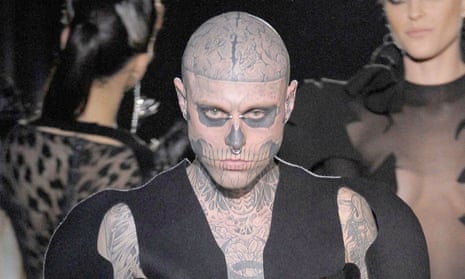Rick Genest, the model known as Zombie Boy, whose heavily tattooed body made him a muse for Lady Gaga, Marc Quinn and numerous fashion designers, has died aged 32.
Dulcedo Management, the Montreal talent and model agency that represented Genest, confirmed his death on Facebook. “The whole Dulcedo family is shocked and saddened by this tragedy,” they wrote, describing Genest as someone who “charmed all hearts” and who was loved by all who met him.
“Thank you ZB for these beautiful moments in your company and for your radiant smile,” they added.
He was found dead at his home in Montreal on Thursday. Police sources told Radio-Canada that his death is being classified as a suicide.

As news of his death broke, tributes poured in to the artist – who went from living on the streets of Montreal as a squeegee kid to high-end modelling shows in Paris and Berlin.
Lady Gaga, who had cast Genest in her 2011 Born This Way video, wrote on Twitter: “The suicide of friend Rick Genest, Zombie Boy is beyond devastating. We have to work harder to change the culture, bring mental health to the forefront and erase the stigma that we can’t talk about it. If you are suffering, call a friend or family today. We must save each other.”
Gaga’s stylist, Nicola Formichetti, who used Genest as a model when he was creative director of Thierry Mugler, said he was “absolutely heartbroken”.
A Facebook account appearing to belong to Genest hinted at depression in a recent post. The May post shows a photo of Genest sitting in a hospital bed, wearing the Kill Me shirt that he often wore for interviews and photos with a tongue depressor hanging from his mouth.
The post echoed a 2012 interview with the UK’s Evening Standard, in which they noted that Genest was reticent to delve into details of his private life. After Genest mentioned – seemingly apropos of nothing – “Depression is a strong thing…” he refused to elaborate when pressed by the reporter.
In a TedX talk last year, titled Normal is an Illusion, Genest described growing up in a small town in Quebec that was riddled with political and racial issues. “French versus English, Mohawks versus the White, very few Blacks and even less other nationalities in between,” he told an audience in Austria.
His parents’ strict religious beliefs kept him sidelined from most school celebrations, forbidden from taking part in what they saw as pagan rituals; carving pumpkins at Halloween, crafting Christmas tree decorations and painting Easter Eggs.
Amid the jocks and preps of high school, he found his place among what he described as the “least favourite of all subcultures”: the goths. “Every day was a battle of final demise, suffering in agony in a world of the ignorant and chipper, bullied by most and befriended by few,” he said.
As a teenager, he was diagnosed with a brain tumour. Doctors warned him that the surgery to remove the tumour would leave his face disfigured for life.
After a six-month wait for the surgery, doctors presented him with another option; a new laser technology that would leave his face intact but which was a gamble, as it had only been carried out successfully on one other person in North America.
Shortly after his 15th birthday, he told the audience in Austria, “I stepped out of the hospital as the second person in North America to survive this new state-of-the-art procedure.”
Years later, he had a falling out with his parents and left home for Montreal, spending the next five or six years sleeping rough, earning money by washing windshields and dodging cops while soaking up the city’s punk scene.
It was around that time that his tattoos began to multiply. “I gradually started resembling a human doodle board, riddled with tattoos,” he said during his TedX talk.
Eventually he met tattoo artist Frank Lewis. The pair devised a theme of a rotting corpse to blend his many tattoos into a tattoo that would cover his whole body, with blackened eye sockets, flesh withering off bones and cockroaches crawling up his neck.
As he turned 21, he got his most eye-catching tattoo; a skull tattooed on his face. At 22, he shaved off his two-foot high mohawk to tattoo an image of his brains on his scalp.
His foray into international fame came soon after, when the UK’s Bizarre Magazine saw photos of him on MySpace and travelled to Montreal to meet him.
From there, photos of him began to spread and his career snowballed. As well as his work with Gaga and Formichetti, he also modelled for Jay-Z’s fashion label Rocawear and appeared in the Keanu Reeves samurai film 47 Ronin. Acclaimed British artist Marc Quinn created a sculpture of Genest in 2011.
Genest explained his phantasmagoric appearance to Wonderland magazine in 2012: “The zombie concept is also often used as a metaphor for runaway consumerism. Rebelling from this notion is the very meaning of punk. The origins of the zombie creature came about from stories of people being buried alive in times of plagues and such crises; that would come out the other side transformed.”
He added: “Zombies, to many, represent a pervasive xenophobia. As in my life, I was often out-casted, hated or misunderstood.”
